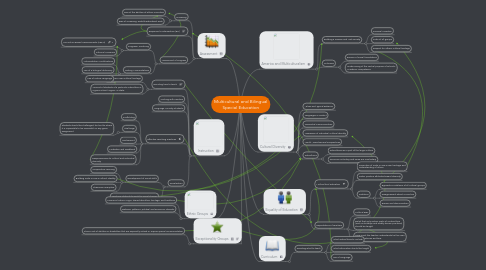
1. Instruction
1.1. Deciding how to teach
1.1.1. Teacher's own cultural heritage
1.1.2. Amount of students of a particular subculture in a given school, region, or state
1.2. Working with Families
1.3. Language Minority Students
1.4. Effective Teaching Practices
1.4.1. Scaffolding
1.4.2. Challenge
1.4.2.1. Students should be challenged, but not to where it is impossible to be successful on any given assignment
1.4.3. Involvement
1.4.4. Mediation and Feedback
1.4.5. Responsiveness to cultural and individual diversity
1.5. Socialization
1.5.1. Development of Social Skills
1.5.1.1. Cooperative Learning
1.5.1.2. Building Pride in one's cultural identity
1.5.1.3. Classroom Discipline
1.5.2. Teaching students to work for social change
2. Ethnic Groups
2.1. Common historic origin, shared identities, heritage, and traditions
2.2. Behavior patterns- political and economic interests
3. Exceptionality Groups
3.1. Share a set of abilities or disabilities that are especially valued or require special accommodation
4. Assessment
4.1. Screening
4.1.1. Bias of the abilities of ethnic minorities
4.1.2. Bias of Screening Tests/Standardized Tests
4.2. Response to Intervention (RTI)
4.3. Assessment of Progress
4.3.1. Progress Monitoring
4.3.1.1. Curriculum Based Measurements (CBMs)
4.3.1.2. Informal Measures
4.3.2. Testing Accomodations
4.3.2.1. Administration Modifications
4.3.2.2. Use of a bilingual dictionary
4.3.2.3. Use of Native Language
5. Cultural Diversity
5.1. Values and Typical Behavior
5.2. Languages or Dialect
5.3. Nonverbal Communication
5.4. Awareness of Individual Cultural Identity
5.5. World Views/General Perspectives
5.6. Subcultures
5.6.1. Subcultures are a part of the larger culture
5.6.2. Some are voluntary and some are involuntary
6. Equality of Education
6.1. Multicultural education
6.1.1. Promotion of Pride in one's own heritage and understanding of others
6.1.2. Foster positive attitudes toward diversity
6.1.3. Problems
6.1.3.1. Egocentric Problems of all cultural groups
6.1.3.2. Disagreement about curriculum
6.1.3.3. Racism and discrimination
6.2. Expectations of Teachers
6.2.1. Cultural Bias
6.2.2. Belief that only certain parts of a subculture (such as holidays and widely known practices) should be taught
6.2.3. How much the teacher understands his/her own cultural histories and bias
7. Curriculum
7.1. Deciding what to teach
7.1.1. Which subcultures to include
7.1.2. What information should be taught
7.1.3. Use of Language
8. America and Multiculturalism
8.1. Building a Diverse and Just Society
8.1.1. Personal Freedom
8.1.2. Pride of all groups
8.1.3. Respect for others' cultural heritage
8.2. Criticisms
8.2.1. Erosion of moral foundations
8.2.2. Undermining of the central purpose of schools: Academic competence
